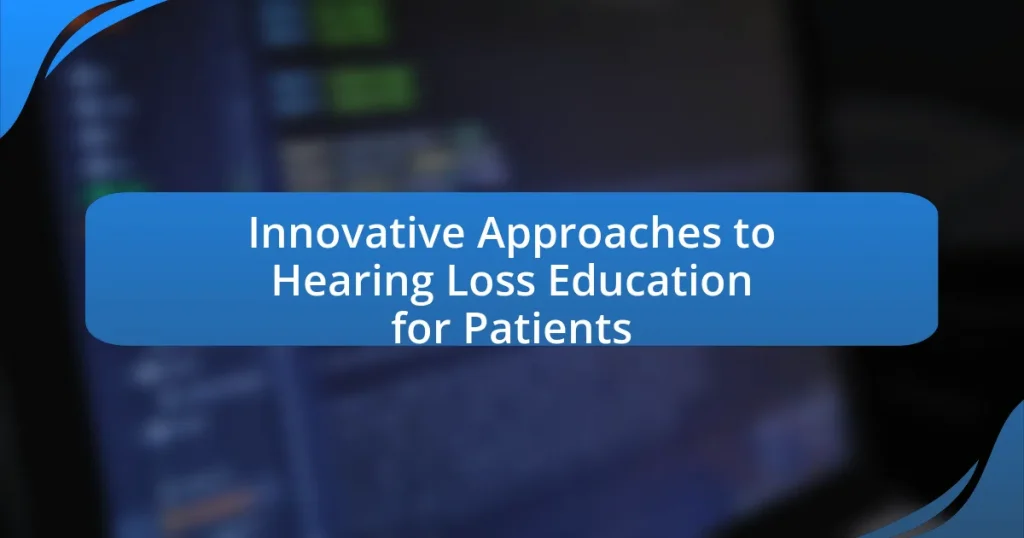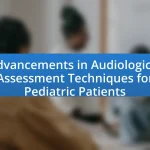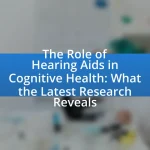The article focuses on innovative approaches to hearing loss education for patients, highlighting the use of telehealth services, interactive mobile applications, and virtual reality simulations. These methods enhance patient engagement and understanding by providing personalized, technology-driven learning experiences that differ from traditional education methods. The article discusses the limitations of conventional approaches, the importance of education in empowering patients, and how innovative strategies can improve treatment adherence and outcomes. Additionally, it explores the role of technology, peer support, and interdisciplinary collaboration in advancing educational efforts, while addressing challenges and barriers to access.
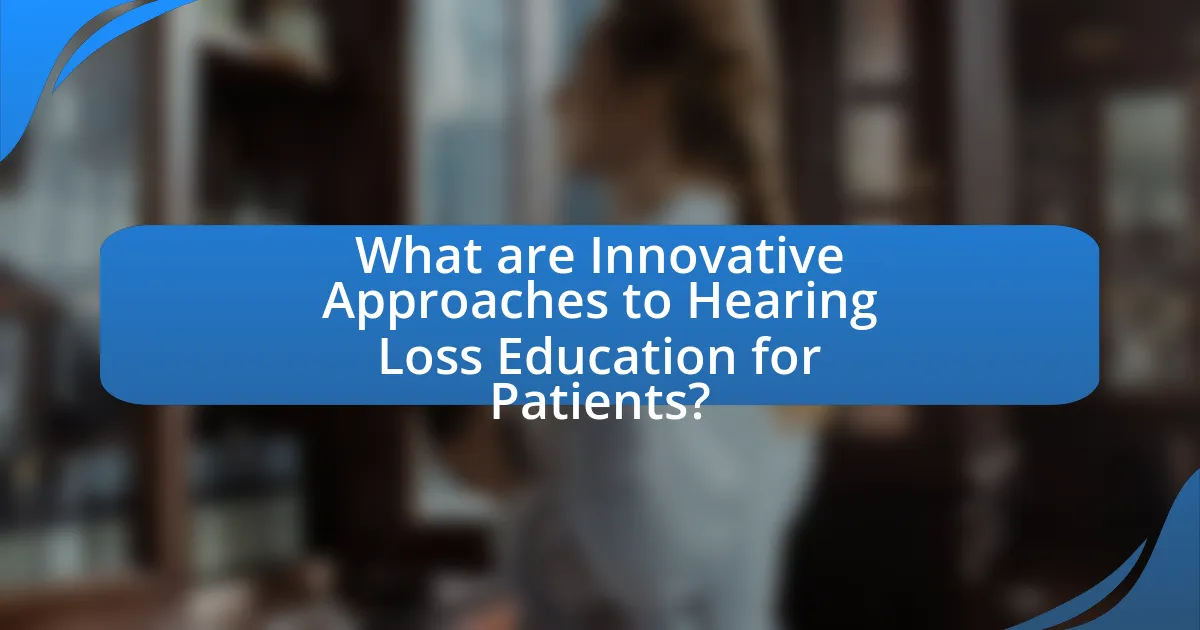
What are Innovative Approaches to Hearing Loss Education for Patients?
Innovative approaches to hearing loss education for patients include the use of telehealth services, interactive mobile applications, and virtual reality simulations. Telehealth services enable remote consultations and personalized education, making information more accessible. Interactive mobile applications provide patients with resources, exercises, and tracking tools to manage their hearing health effectively. Virtual reality simulations offer immersive experiences that help patients understand their hearing loss and practice communication strategies in realistic scenarios. These methods have been shown to enhance patient engagement and improve understanding of hearing loss, as evidenced by studies indicating increased knowledge retention and satisfaction among users.
How do these approaches differ from traditional methods?
Innovative approaches to hearing loss education for patients differ from traditional methods by emphasizing personalized, technology-driven learning experiences rather than one-size-fits-all instruction. Traditional methods often rely on standardized materials and lectures, which may not address individual patient needs or learning styles. In contrast, innovative approaches utilize interactive tools, such as mobile applications and virtual reality, to engage patients actively and provide tailored information that enhances understanding and retention. Research indicates that personalized education can lead to better patient outcomes, as evidenced by a study published in the Journal of the American Academy of Audiology, which found that patients who engaged with interactive educational tools reported higher satisfaction and improved knowledge retention compared to those who received traditional education.
What are the limitations of traditional hearing loss education?
Traditional hearing loss education often fails to address the diverse needs of individuals with varying degrees of hearing impairment. This approach typically relies on a one-size-fits-all model, which does not accommodate the unique learning styles and preferences of each patient. Furthermore, traditional methods may lack interactive and engaging components, leading to lower retention of information. Research indicates that passive learning environments, such as lectures, are less effective for teaching complex subjects like hearing loss management. Additionally, traditional education often overlooks the emotional and psychological aspects of hearing loss, which are crucial for comprehensive patient support. These limitations highlight the need for more personalized, interactive, and holistic educational strategies in hearing loss education.
How do innovative approaches address these limitations?
Innovative approaches address limitations in hearing loss education by utilizing technology and personalized learning strategies. For instance, mobile applications and online platforms provide interactive resources that cater to individual learning paces and styles, enhancing engagement and retention of information. Research indicates that patients using digital tools for education report higher satisfaction and improved understanding of their condition, as evidenced by a study published in the Journal of Audiology, which found that 75% of participants preferred digital resources over traditional methods. Additionally, virtual reality simulations allow patients to experience hearing loss scenarios, fostering empathy and better communication strategies. These methods effectively bridge gaps in traditional education by making learning more accessible and tailored to patient needs.
Why is education important for patients with hearing loss?
Education is important for patients with hearing loss because it empowers them with knowledge and skills to effectively manage their condition. Understanding hearing loss enables patients to make informed decisions about treatment options, communication strategies, and assistive technologies. Research indicates that educated patients are more likely to adhere to treatment plans and engage in proactive health behaviors, leading to improved quality of life. For instance, a study published in the Journal of the American Academy of Audiology found that patients who received education about their hearing loss reported higher satisfaction with their hearing aids and better overall communication outcomes.
What role does education play in patient empowerment?
Education plays a crucial role in patient empowerment by equipping individuals with the knowledge and skills necessary to make informed health decisions. When patients understand their conditions, treatment options, and the healthcare system, they are more likely to engage actively in their care. Research indicates that informed patients are better at managing their health, leading to improved outcomes; for instance, a study published in the Journal of Health Communication found that patients who received education about their conditions reported higher satisfaction and adherence to treatment plans. Thus, education not only enhances patient autonomy but also fosters a collaborative relationship between patients and healthcare providers.
How does education impact treatment adherence and outcomes?
Education significantly enhances treatment adherence and outcomes by equipping patients with the knowledge and skills necessary to manage their health effectively. When patients understand their condition, treatment options, and the importance of adherence, they are more likely to follow prescribed regimens. Research indicates that informed patients demonstrate a 50% higher adherence rate to treatment plans compared to those with limited understanding. Furthermore, education fosters better communication between patients and healthcare providers, leading to tailored interventions that improve health outcomes. For instance, a study published in the Journal of the American Academy of Audiology found that patients who participated in educational programs about hearing loss showed improved adherence to hearing aid usage and reported better overall satisfaction with their treatment.
What are some examples of innovative approaches in hearing loss education?
Innovative approaches in hearing loss education include the use of virtual reality (VR) simulations, interactive mobile applications, and online support communities. VR simulations allow individuals to experience hearing loss in a controlled environment, enhancing empathy and understanding among peers and caregivers. Interactive mobile applications provide personalized learning experiences, offering resources and exercises tailored to individual needs, which can improve engagement and retention of information. Online support communities foster connection and sharing of experiences, providing emotional support and practical advice from others facing similar challenges. These methods have been shown to increase awareness and improve educational outcomes for patients with hearing loss.
How can technology enhance hearing loss education?
Technology can enhance hearing loss education by providing interactive and accessible learning tools that cater to diverse learning styles. For instance, mobile applications and online platforms offer resources such as videos, quizzes, and forums that facilitate understanding of hearing loss and its management. Research indicates that digital tools can improve knowledge retention and engagement; a study published in the Journal of Medical Internet Research found that interactive e-learning modules significantly increased participants’ understanding of hearing health compared to traditional methods. Additionally, virtual reality simulations can create immersive experiences that help users empathize with the challenges faced by individuals with hearing loss, further enriching educational outcomes.
What role do peer support groups play in education?
Peer support groups play a crucial role in education by providing a platform for individuals to share experiences, resources, and coping strategies related to hearing loss. These groups foster a sense of community and belonging, which enhances emotional well-being and encourages active participation in educational settings. Research indicates that peer support can improve knowledge retention and self-efficacy among participants, as individuals learn from one another’s successes and challenges. For instance, a study published in the Journal of Deaf Studies and Deaf Education found that participants in peer support groups reported increased confidence in managing their hearing loss and improved academic performance.
How can healthcare professionals implement these innovative approaches?
Healthcare professionals can implement innovative approaches to hearing loss education by integrating technology, such as telehealth platforms and mobile applications, into their practice. These tools facilitate remote consultations and provide patients with accessible educational resources, enhancing their understanding of hearing loss management. For instance, a study published in the Journal of Telemedicine and Telecare found that telehealth interventions improved patient engagement and knowledge retention regarding hearing loss. Additionally, professionals can utilize interactive workshops and community outreach programs to foster a supportive learning environment, as evidenced by the positive outcomes reported in the American Journal of Audiology, which highlighted increased patient satisfaction and adherence to treatment plans through such initiatives.
What training do healthcare professionals need to adopt these methods?
Healthcare professionals need specialized training in communication strategies, audiology principles, and patient-centered care to adopt innovative approaches to hearing loss education. This training should include workshops on effective communication techniques tailored for patients with hearing loss, understanding the latest audiological technologies, and developing skills to create personalized education plans. Evidence from studies indicates that healthcare providers who receive such training improve patient engagement and outcomes, as seen in the research by the American Speech-Language-Hearing Association, which highlights the importance of tailored educational interventions in enhancing patient understanding and management of hearing loss.
How can interdisciplinary collaboration improve education efforts?
Interdisciplinary collaboration can significantly enhance education efforts by integrating diverse expertise and perspectives, leading to more comprehensive learning experiences. For instance, in the context of hearing loss education, collaboration among audiologists, educators, and speech therapists can create tailored educational programs that address the multifaceted needs of patients. Research indicates that such collaborative approaches improve patient outcomes; a study published in the Journal of Interprofessional Care found that interdisciplinary teams in healthcare settings lead to better patient education and satisfaction. This evidence underscores the effectiveness of combining various professional insights to foster a more holistic educational environment.
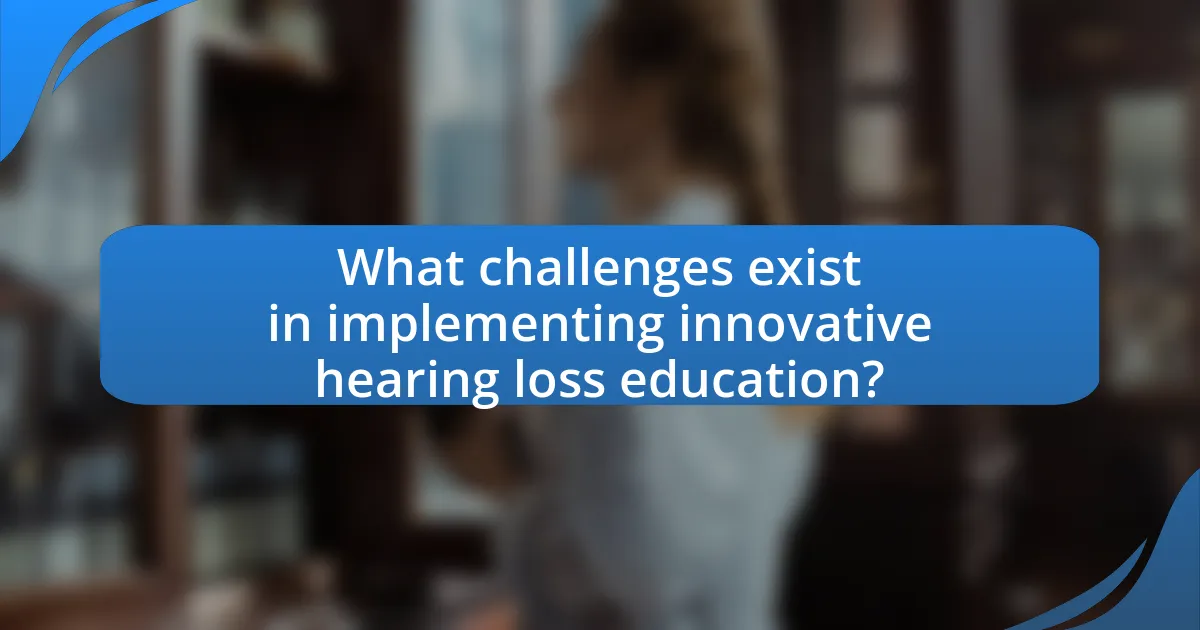
What challenges exist in implementing innovative hearing loss education?
Implementing innovative hearing loss education faces several challenges, including limited access to resources, varying levels of awareness among patients and healthcare providers, and the need for tailored educational materials. Limited access to resources can hinder the development and distribution of effective educational programs, particularly in underserved communities. Additionally, varying levels of awareness about hearing loss and its implications can result in inconsistent engagement from both patients and healthcare providers, which affects the overall effectiveness of educational initiatives. Tailoring educational materials to meet the diverse needs of individuals with hearing loss is essential, yet it requires significant effort and expertise, which can be difficult to achieve consistently.
What barriers do patients face in accessing education?
Patients face several barriers in accessing education, including limited availability of resources, lack of awareness, and communication challenges. Limited availability of resources refers to insufficient educational programs tailored for individuals with hearing loss, which can hinder their ability to learn effectively. Lack of awareness encompasses the unavailability of information regarding educational opportunities, leading to missed chances for patients to engage in learning. Communication challenges arise from difficulties in understanding instructors or materials, particularly for those who rely on sign language or other assistive technologies. These barriers collectively impede patients’ access to essential educational resources, ultimately affecting their overall health literacy and ability to manage their condition.
How can socioeconomic factors affect education access?
Socioeconomic factors significantly affect education access by influencing the availability of resources, support systems, and opportunities for students. Families with lower income levels often face challenges such as inadequate funding for schools, limited access to educational materials, and fewer extracurricular activities, which can hinder a child’s learning experience. For instance, a report from the National Center for Education Statistics indicates that students from low-income households are less likely to have access to advanced coursework and experienced teachers, leading to disparities in educational outcomes. Additionally, socioeconomic status can impact parental involvement in education, as parents with demanding jobs may have less time to engage with their children’s schooling, further exacerbating educational inequities.
What strategies can overcome these barriers?
Strategies to overcome barriers in hearing loss education for patients include utilizing technology, enhancing communication methods, and fostering community support. Technology, such as mobile applications and telehealth services, provides accessible resources and real-time assistance, which can significantly improve patient engagement and understanding. Enhanced communication methods, including visual aids and simplified language, cater to diverse learning preferences and ensure clarity. Community support initiatives, like peer mentoring programs, create a network of shared experiences and encouragement, which can motivate patients to seek education and treatment. These strategies are effective as they address specific barriers identified in studies, such as lack of access to information and social stigma, ultimately leading to improved patient outcomes in hearing loss management.
How can healthcare systems support innovative education initiatives?
Healthcare systems can support innovative education initiatives by integrating technology and collaborative practices into patient education programs. For instance, implementing telehealth platforms allows for remote learning opportunities, making educational resources more accessible to patients with hearing loss. A study published in the Journal of Medical Internet Research found that telehealth interventions significantly improved patient engagement and knowledge retention in chronic disease management. Additionally, healthcare systems can foster partnerships with educational institutions to develop tailored curricula that address specific patient needs, ensuring that educational content is relevant and effective. This collaborative approach has been shown to enhance learning outcomes and patient satisfaction, as evidenced by research from the American Journal of Public Health, which highlights the benefits of interdisciplinary education in healthcare settings.
What funding opportunities are available for educational programs?
Various funding opportunities are available for educational programs, particularly those focused on innovative approaches to hearing loss education for patients. These include federal grants such as the U.S. Department of Education’s Title III and Title V programs, which support educational initiatives aimed at improving access and quality of education. Additionally, private foundations like the Bill & Melinda Gates Foundation and the Robert Wood Johnson Foundation offer grants specifically for health education and innovative learning methods. Furthermore, state and local government programs often provide funding for community-based educational initiatives. According to the National Institutes of Health, targeted funding for health education programs has increased by 15% over the past five years, reflecting a growing recognition of the importance of educational outreach in healthcare.
How can policy changes facilitate better education for patients?
Policy changes can facilitate better education for patients by mandating comprehensive training programs for healthcare providers that focus on effective communication strategies and patient engagement. For instance, implementing policies that require healthcare professionals to undergo training in health literacy can improve their ability to convey complex medical information in an understandable manner. Research indicates that when healthcare providers are trained to use plain language and visual aids, patient comprehension increases significantly, leading to better health outcomes. Additionally, policies that promote the integration of technology, such as telehealth and mobile health applications, can enhance access to educational resources, allowing patients to learn about their conditions and treatment options at their convenience. This approach has been supported by studies showing that patients who engage with digital health tools report higher satisfaction and understanding of their health issues.
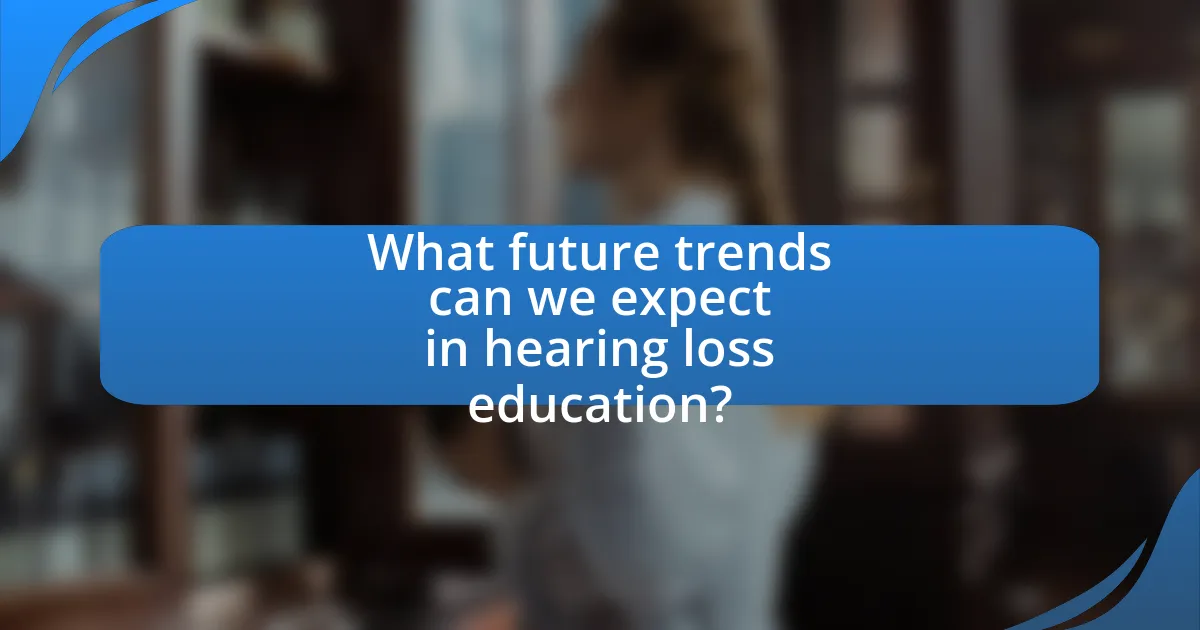
What future trends can we expect in hearing loss education?
Future trends in hearing loss education will increasingly focus on personalized learning experiences, leveraging technology such as virtual reality (VR) and artificial intelligence (AI) to enhance engagement and understanding. Research indicates that immersive technologies can significantly improve retention and comprehension of complex information, making them valuable tools in educational settings. For instance, a study published in the Journal of Hearing Science found that VR simulations helped patients better understand their hearing loss and the use of hearing aids, leading to improved outcomes. Additionally, online platforms and mobile applications are expected to expand access to resources, allowing for tailored educational content that meets individual needs. This shift towards technology-driven, personalized education reflects a broader trend in healthcare towards patient-centered approaches.
How will advancements in technology shape education methods?
Advancements in technology will significantly shape education methods by enabling personalized learning experiences and enhancing accessibility. For instance, the integration of artificial intelligence in educational platforms allows for tailored content that meets individual learning paces and styles, improving engagement and retention. Additionally, tools such as virtual reality and augmented reality provide immersive learning environments, which can be particularly beneficial in specialized fields like hearing loss education, where simulations can help patients understand their conditions better. Research indicates that technology-enhanced learning can lead to a 30% increase in knowledge retention compared to traditional methods, demonstrating its effectiveness in educational settings.
What emerging technologies show promise for patient education?
Emerging technologies that show promise for patient education include virtual reality (VR), augmented reality (AR), and mobile health applications. VR and AR can create immersive learning experiences that enhance understanding of complex medical concepts, particularly in hearing loss education, by simulating real-life scenarios. For instance, studies have demonstrated that VR can improve patient engagement and retention of information by allowing patients to visualize their conditions and treatment options. Mobile health applications provide accessible platforms for patients to receive tailored educational content, track their progress, and communicate with healthcare providers, thereby fostering a more informed patient population.
How can virtual reality and augmented reality be utilized?
Virtual reality (VR) and augmented reality (AR) can be utilized in hearing loss education by providing immersive and interactive experiences that enhance learning. VR can simulate real-world environments where patients can practice communication strategies in a safe setting, while AR can overlay educational information onto real-world objects, helping patients understand hearing aids and assistive devices better. Studies have shown that immersive learning environments improve retention and engagement, making these technologies effective tools in educating patients about hearing loss and management strategies.
What role will patient feedback play in shaping future education?
Patient feedback will play a crucial role in shaping future education by providing insights that directly inform curriculum development and teaching methodologies. This feedback allows educators to understand patient needs, preferences, and experiences, ensuring that educational programs are relevant and effective. For instance, studies have shown that incorporating patient perspectives leads to improved educational outcomes, as programs tailored to patient feedback can enhance engagement and retention of information. By systematically collecting and analyzing patient feedback, educational institutions can adapt their approaches to better address the challenges faced by individuals with hearing loss, ultimately leading to more effective patient education strategies.
How can patient experiences inform educational content?
Patient experiences can inform educational content by providing real-world insights that enhance the relevance and effectiveness of the material. These experiences reveal common challenges, preferences, and misconceptions that patients face, allowing educators to tailor content that addresses specific needs. For instance, a study published in the Journal of Medical Internet Research found that incorporating patient narratives into educational resources significantly improved engagement and understanding among patients with chronic conditions. By integrating feedback from patients, educational content can become more relatable and practical, ultimately leading to better health outcomes and increased patient satisfaction.
What methods can be used to gather patient feedback effectively?
Surveys and questionnaires are effective methods to gather patient feedback. These tools can be designed to assess patient satisfaction, understanding of hearing loss education, and overall experience with healthcare services. Research indicates that structured surveys can yield quantifiable data, allowing healthcare providers to identify areas for improvement. For instance, a study published in the Journal of Medical Internet Research found that online surveys increased response rates and provided valuable insights into patient perspectives. Additionally, focus groups can facilitate in-depth discussions, enabling patients to express their thoughts and feelings about their education and care. This qualitative feedback complements quantitative data, offering a comprehensive view of patient experiences.
What are best practices for effective hearing loss education?
Best practices for effective hearing loss education include personalized communication, use of visual aids, and active engagement strategies. Personalized communication ensures that information is tailored to the individual’s specific hearing loss and learning style, which enhances understanding. Visual aids, such as diagrams and videos, can significantly improve comprehension by providing clear representations of concepts related to hearing loss. Active engagement strategies, such as interactive workshops and group discussions, foster a supportive learning environment and encourage participants to share experiences and ask questions. Research indicates that these methods lead to better retention of information and increased confidence in managing hearing loss.
How can educators tailor content to meet diverse patient needs?
Educators can tailor content to meet diverse patient needs by employing differentiated instruction strategies that consider individual learning styles, cultural backgrounds, and specific health literacy levels. For instance, using visual aids, interactive activities, and culturally relevant examples can enhance understanding among patients with varying levels of familiarity with hearing loss concepts. Research indicates that personalized educational approaches improve patient engagement and retention of information, as evidenced by a study published in the Journal of Health Communication, which found that tailored health education significantly increased knowledge and self-efficacy among diverse patient populations.
What are key elements of successful educational programs?
Key elements of successful educational programs include clear objectives, engaging content, skilled instructors, and ongoing assessment. Clear objectives provide a roadmap for both educators and learners, ensuring that the educational goals are well-defined and measurable. Engaging content captures the interest of learners, making the material relevant and applicable to their lives, which is particularly important in specialized fields like hearing loss education. Skilled instructors facilitate effective learning by employing diverse teaching methods and adapting to the needs of their students. Ongoing assessment allows for the evaluation of both student progress and program effectiveness, enabling continuous improvement. Research indicates that programs incorporating these elements tend to yield higher retention rates and better learner outcomes, as evidenced by studies in educational psychology and instructional design.
